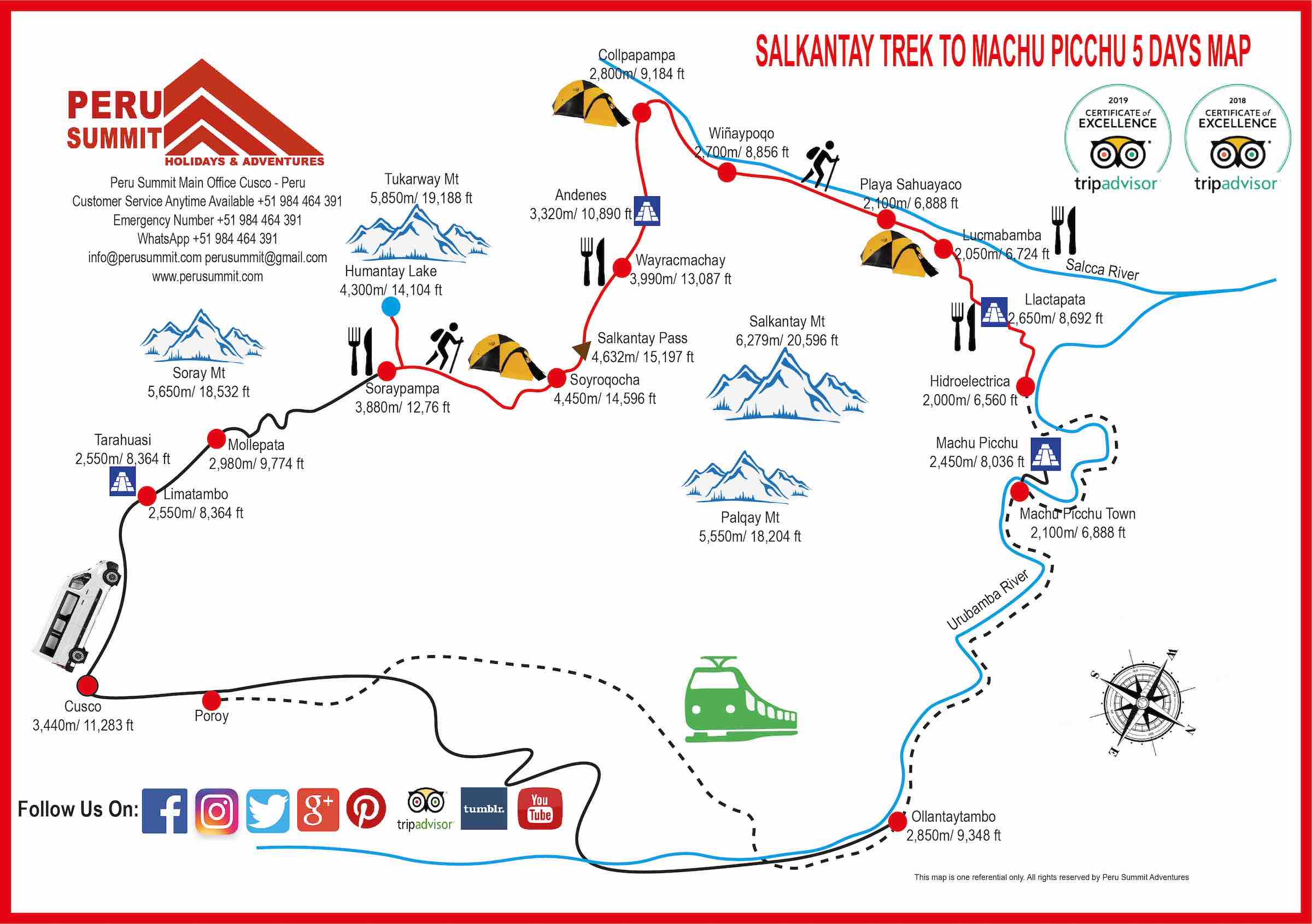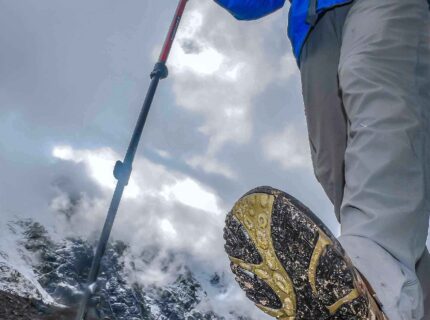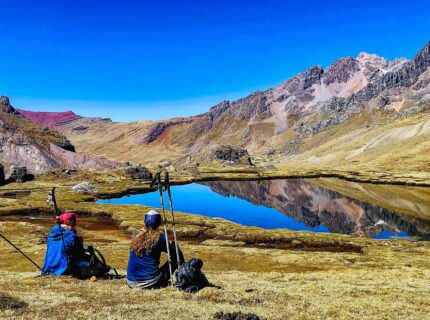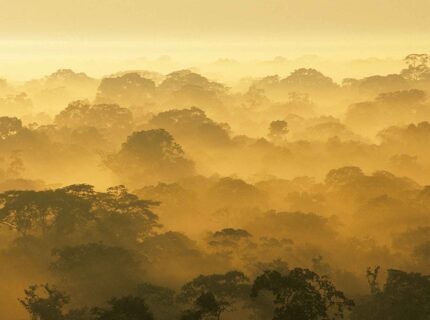
Salkantay Trek



The Salkantay Trek is a popular alternative trek to Machu Picchu in Peru. It is named after the Salkantay Mountain, which is located in the Vilcabamba mountain range of the Andes, and is one of the highest peaks in the Cusco region at 6,271 meters (20,574 feet).
The trek usually takes around 4-5 days, and covers a distance of approximately 74 kilometers (46 miles). The trek starts in Mollepata, a town located about 100 kilometers (62 miles) northwest of Cusco, and ends in Aguas Calientes, the town located at the base of Machu Picchu.
The Salkantay Trek offers stunning views of the Andean landscape, including snow-capped mountains, deep valleys, and tropical forests. Along the way, trekkers will pass through remote Andean villages, encounter diverse flora and fauna, and cross the Salkantay Pass at an altitude of 4,630 meters (15,190 feet).
The trek is considered to be challenging and requires a good level of physical fitness, as well as proper acclimatization to the altitude. However, it is a rewarding experience for those who enjoy trekking and want to see the beauty of the Andes Mountains and Machu Picchu.
The Salkantay Trek to Machu Picchu is a popular alternative to the classic Inca Trail, offering a challenging and scenic trek through the Andes Mountains. Here are some of the highlights of the Salkantay Trek:
Salkantay Mountain: The trek is named after the Salkantay Mountain, which is one of the highest peaks in the region. The stunning snow-capped mountain offers a breathtaking view and is a popular spot for photography.
Scenic Views: The trek offers spectacular views of the Andean landscape, including deep valleys, lush tropical forests, and high-altitude plateaus. The trek also passes through traditional Andean villages where you can learn about the local culture and traditions.
Humantay Lake: On the first day of the trek, you’ll have the opportunity to visit the beautiful Humantay Lake, which is surrounded by towering mountains and is known for its stunning turquoise waters.
Salkantay Pass: The trek involves crossing the Salkantay Pass, which is located at an altitude of 4,630 meters (15,190 feet). The pass offers panoramic views of the surrounding mountains and valleys.
Machu Picchu: The Salkantay Trek ends with a visit to Machu Picchu, one of the most famous and iconic archaeological sites in the world. You’ll have the opportunity to explore the ancient ruins and learn about the history and culture of the Inca civilization.
Overall, the Salkantay Trek offers a challenging and rewarding experience, with stunning scenery and a unique perspective on the Andean region of Peru.
While the Salkantay Trek does not require permits like the classic Inca Trail, there are still regulations in place to help protect the environment and ensure the safety of trekkers. Here are some of the regulations for the Salkantay Trek:
Trek with a licensed tour operator: A tour operator is very important to organize all logistics. This is to ensure the safety of the group, as well as to provide valuable information about the local culture, history, and environment through their professional guides.
Stay on designated trails: To protect the fragile ecosystem of the Andean region, trekkers must stay on designated trails and avoid damaging vegetation or disturbing wildlife.
Leave no trace: Trekkers are expected to practice Leave No Trace principles, which include packing out all trash and waste and minimizing impact on the environment.
Respect local communities: The Salkantay Trek passes through several traditional Andean communities, and trekkers are expected to be respectful of local customs and traditions.
Do not litter or pollute water sources: Trekkers must dispose of all waste properly and are prohibited from polluting or contaminating water sources along the trail.
Acclimate to the altitude: Due to the high altitude of the Salkantay Trek, trekkers are recommended to spend a few days in Cusco or other high-altitude locations to acclimate before starting the trek.
By following these regulations, trekkers can help to protect the environment and ensure a safe and enjoyable experience on the Salkantay Trek.
The trek is available all year round, but we recommend hiking in the dry season which starts from Mid-April until October, it’s when the weather is pretty good for hiking. December to March is the rainy season so big showers are very often.
If connecting with the Classic Inca Trail and Short Inca Trail, you need to obtain a special permit that grants you to hike the ancient Inca trail and visit Machu Picchu, these tickets are limited per day to 250 permits for Short Inca Trail and 500 permites for the Classic 4-day Trek so it is important to book them 2-3 months in advance at least.
The weather on the Salkantay Trek can vary greatly depending on the season and altitude. The best time to trek the Salkantay route is during the dry season, which runs from April to October. During this time, the weather is generally dry and sunny, with clear blue skies and cool temperatures.
In the high-altitude areas, temperatures can drop below freezing at night, so warm clothing is essential. During the day, temperatures can range from about 10°C to 20°C (50°F to 68°F), depending on the altitude and location along the trail.
During the rainy season, which runs from November to March, the weather can be unpredictable and rainy, with muddy and slippery trail conditions. However, some trekkers still choose to trek during this time, as the landscape can be even more lush and beautiful, and there are generally fewer crowds on the trail.
It’s important to pack for a variety of weather conditions and to be prepared for changes in temperature and weather along the trail. It’s also recommended to check the weather forecast before starting the trek and to pack accordingly.
The campsites on the Salkantay Trek are generally basic, but comfortable and provide all the necessary amenities for a successful trek. Here’s what you can expect from the campsites:
Tents: Trekkers will sleep in sturdy, waterproof tents that are set up by the support staff at each campsite.
Dining tent: A large dining tent is set up for meals, which is usually equipped with tables, chairs, and a gas stove for cooking.
Sleeping gear: The trekking company usually provides sleeping bags and foam mats to keep you warm and comfortable during the night.
Toilet facilities: Basic toilet facilities are available at each campsite, usually in the form of a portable toilet or a simple pit toilet.
Water supply: Trekkers are provided with safe drinking water throughout the trek, which is either boiled or purified with tablets.
Views: Many campsites offer stunning views of the surrounding Andean landscape, including snow-capped peaks, deep valleys, and lush forests.
It’s important to note that the campsites are located in remote areas, and there can be some very basic other accommodations available along the trail. Trekkers should be prepared to spend several nights camping in basic conditions, but the experience is worth it for the stunning scenery and unique cultural immersion.
Preparing for the Salkantay Trek is essential to ensure a safe, enjoyable, and successful trek. Here are some tips to help you prepare for the Salkantay Trek:
Train physically: The Salkantay Trek involves several days of hiking at high altitude, so it’s important to train physically before the trek. Start with shorter hikes and gradually increase the length and difficulty of your training hikes.
Acclimate to the altitude: The Salkantay Trek reaches altitudes of up to 4,600 meters (15,091 feet), which can cause altitude sickness. It’s important to spend a few days in Cusco or other high-altitude locations to acclimate before starting the trek.
Pack properly: Pack light, but be sure to bring warm clothing for cold nights, rain gear, comfortable hiking boots, and a good quality backpack. Your trekking company may provide a recommended packing list.
Stay hydrated: Drink plenty of water to stay hydrated, especially at high altitudes. Your trekking company will provide safe drinking water, but it’s also a good idea to bring water purification tablets or a filter.
Prepare mentally: The Salkantay Trek can be challenging, both physically and mentally. Be prepared to push yourself and stay positive, and remember to take breaks when you need them.
Learn about the local culture: The Salkantay Trek passes through several traditional Andean communities, so it’s a good idea to learn about the local culture and customs before the trek.
Follow the regulations: To protect the environment and ensure a safe trek, it’s important to follow the regulations of the Salkantay Trek. Stay on designated trails, respect local communities, and practice Leave No Trace principles.
By following these tips and preparing properly for the Salkantay Trek, you can have an unforgettable experience exploring the stunning Andean landscape and immersing yourself in the local culture.

Here are some trek tips to help you make the most of your Salkantay Trek:
Pace yourself: The Salkantay Trek is a challenging hike, so it’s important to pace yourself and take breaks when needed. Don’t push yourself too hard on the first day, and take time to rest and acclimate to the altitude.
Stay hydrated: It’s important to drink plenty of water to stay hydrated, especially at high altitudes. Your trekking company will provide safe drinking water, but it’s also a good idea to bring water purification tablets or a filter.
Dress in layers: The weather on the Salkantay Trek can be unpredictable, so it’s important to dress in layers. Bring warm clothing for cold nights, rain gear for wet days, and comfortable hiking boots with good ankle support.
Bring snacks: Trekking can be tiring, and it’s important to keep your energy levels up. Bring high-energy snacks like trail mix, granola bars, and dried fruit to eat between meals.
Respect the environment: The Salkantay Trek passes through pristine wilderness areas and traditional Andean communities. It’s important to respect the environment, stay on designated trails, and practice Leave No Trace principles.
Learn about the local culture: The Salkantay Trek offers a unique opportunity to immerse yourself in the local culture. Learn about the customs and traditions of the Andean communities you visit, and be respectful of local people and their way of life.
Be prepared for changes: The weather on the Salkantay Trek can be unpredictable, and changes in itinerary may be necessary due to weather or other unforeseen circumstances. Be flexible and open to changes, and trust your trekking company to make the best decisions for your safety and enjoyment.
By following these trek tips, you can have a safe and enjoyable Salkantay Trek, and make unforgettable memories exploring the stunning Andean landscape.
With Peru Summit Adventures on this trek, food is awesome and well balanced, you will have enough food from varieties of vegetables, pasta, chicken, beef, quinoa, local potatoes, trout, porridge for breakfast, coffee, milk, and much more things, all this prepared by an experienced cook, which will be served in comfortable tents with tables, chairs, lamps. You will also have options for vegetarians, vegans, or gluten-free. When going with other companies make sure to ask if the food will be enough and fresh.
The Salkantay Trek to Machu Picchu is not only a stunning trek through the Andean mountains, but it also offers the opportunity to visit several other attractions along the way. Here are some other places you can see during the Salkantay Trek:
Humantay Lake: On the second day of the trek, you can take a detour to visit Humantay Lake, a stunning turquoise-colored lake located at the base of Humantay Mountain. The hike to the lake is challenging but rewarding, and the views are breathtaking.
Llactapata: On the third or fought day of the trek, you’ll reach Llactapata, an Inca archaeological site located on a ridge with stunning views of Machu Picchu. The site is believed to have served as a resting place for Inca travelers on their way to Machu Picchu.
Aguas Calientes: At the end of the trek, you’ll reach the town of Aguas Calientes, which is the gateway to Machu Picchu. The town has hot springs, a market, and several restaurants and cafes.
Machu Picchu: The highlight of the Salkantay Trek is, of course, Machu Picchu. The ancient Inca citadel is one of the most impressive archaeological sites in the world and is a must-see attraction for anyone visiting Peru.
By doing the Salkantay Trek, you not only get to experience a breathtaking trek through the Andean mountains but also get to visit some of the most amazing attractions in Peru.
See below our list of the Salkantay Trek to Machu Picchu tours, click on each option to see further information.
Here are some frequently asked questions (FAQs) about the Salkantay Trek to Machu Picchu:
How long is the Salkantay Trek?
The Salkantay Trek is typically a 5-day, 4-night trek, although there are also shorter and longer options available.
Do I need to be in good physical condition to do the Salkantay Trek?
Yes, the Salkantay Trek is a challenging trek that involves hiking at high altitudes and over difficult terrain. It’s important to be in good physical condition and have previous hiking experience.
What is the altitude of the Salkantay Trek?
The highest point of the Salkantay Trek is the Salkantay Pass, which is at an altitude of 4,600 meters (15,091 feet).
Do I need to acclimatize before doing the Salkantay Trek?
Yes, it’s recommended that you spend at least 2-3 days in Cusco or another high-altitude location before starting the Salkantay Trek to acclimatize to the altitude.
Do I need a permit to do the Salkantay Trek?
No, you don’t need a permit to do the Salkantay Trek. However, you do need to book the trek through a licensed tour operator.
What is the best time of year to do the Salkantay Trek?
The best time to do the Salkantay Trek is during the dry season, which runs from May to September. However, it’s possible to do the trek year-round.
What should I bring to the Salkantay Trek?
You should bring warm clothing, rain gear, comfortable hiking boots, a daypack, a water bottle, snacks, and any necessary medication. Your trekking company will provide sleeping bags and tents.
Is it safe to do the Salkantay Trek?
Yes, the Salkantay Trek is generally considered safe, as long as you book with a licensed tour operator and follow their instructions. However, it’s important to be aware of the risks of hiking at high altitudes and over difficult terrain.
By knowing the answers to these frequently asked questions, you can better prepare for and enjoy your Salkantay Trek to Machu Picchu.












We can customize this private tour just for you. Any detail can be tailored – activities, length, hotels, and other destinations as well as we can accommodate this tour to the photography experience. Use the form below to start planning your experience of a lifetime.
The experts at Peru Summit Adventures specialize in crafting highly-customized trips. We look forward to answering your questions about your upcoming travel plans. Get started by filling out the information below.